History
Below you can read about the beginning and further history of the NVMB (Belgian country tramways)
1. Introduction
Already since a century in Belgium there has been an existence of tramways. In and around the large cities, but specialy also in the countryside there was a large network. In this document you can read something about the history, the evolution and the rolling stock of the NMVB.
2. Prelude
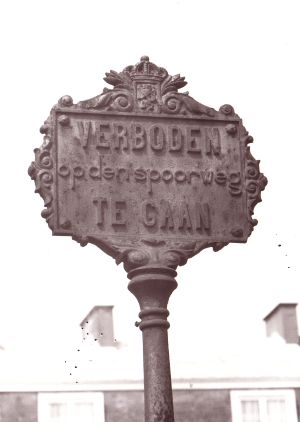
Since the middle of the 19th century there was a dense network of railways in Belgium. The government stimulated in an early stage the construction of the railways. As a consequence of this many companies were established. These companies fixed their eye to the large distances; there it gave the best return on investment. Connections between large cities, connections between smaller cities and a large city somewhere further on, they all came about very soon.
On the countryside, these companies could not earn enough. Only a small number of people lived there. A second reason was a crisis (especially felt in agricultural business) in the eighties of the 19th century. An argument, that trains were needed to transport agricultural products, had no value. Remember, that there were not yet motorcars to do this. Besides this, it was not paying for the railway companies to build railway lines from cities to smaller villages around them.
The government looked at this with sadness. She thought it necessary to change this, and to stimulate the possibility to go from villages to the city. The government did this by making it possible by means of a law to build railways for which smaller requirements were necessary than for the main railways. A small railway (a tramway) can be built cheaper. And so, she thought, the private sector would start building railways.
In 1875 the "law for the tramways" was accepted in the Second Chamber and in the Senate. It was made possible to construct light railways (maximum speed 20 to 40 km/h).
In the large cities, this law had a great impact. In Antwerp, Gent, Verviers, Liege, Brussels and Charleroi very soon tramways were built. The private sector invested in lines in these environments. But on the countryside things remained as they were. Apart from a few exceptions no tramways were built.
3. A second trial

As has been said, no tramways were constructed on the countryside of Belgium. The government did not want to build them herself, the private sector was of the opinion, that not enough could be earned. Because the government saw, that tramways were necessary for the economical development, in 1880 she made a committee to have research for a network of local tramways. This committee worked fast, and directed herself to a combination of private and governmental capital. In the past the government had seen a bad outcome of the private railways, of which she was obliged to buy them back for much money. A second financial debacle was something that the government did not want.
The tramway committee came in 1881 with a proposal. Lines should be built by the state (country, provinces, communities together), after which private entrepreneurs should run the daily operation. After comprehensive studies, in 1884 the law for the local tramways was approved by both the chambers. After some remarks a second law was approved in 1885, so the birth of the NMVB can be set to 1885.
4. Providing of capital
As mentioned before, the capital for building the tramways should be provided by the government, eventually together with the private sector. This is how it came out. The country supplied in early stages a quarter of the capital, and later on even half the capital. Each province supplied a quarter to a thirth of the capital, and the remainder was supplied by the municipalities by which a line would pass. It was also possible for private companies to pay a part of the capital (think about a factory, for which it would be possible to transport goods it made). But the last did not happen so much.
This ratio of raising capital had as an outcome, that also communities would feel responsable for the line within their community boundaries.
Because the government could not raise all of the capital in about 10 years, she made loans which would be paid off in a much larger period of years. So the government could simply raise the funds which were needed, and the people who accepted this loans could recon on a garanteed repayment by the government.
5. Forms of operation
The government decided (a wise decision) not to work the tramways herself. The NMVB built the line, and would later on take care of maintenance. The rolling stock was also supplied by the NMVB. A private enterpreneur could run the line. To guarantee a minimum of provisions, the NMVB ordered a minimum of rides per day. If an enterpreneur felt it necessary, of course he was allowed to make more rides a day, but then for own risk.
To prevent that lines in closely densed areas would make a large profit, but on the contrary lines in sparsely densed areas would make a loss, the profits of the first lines were distributed among other lines. A part of the profit should be reserved for maintenance and extension of the own line. It was ordered that another part of the profit would be given to a fund of the NMVB, from which loss making lines could be supported.
The organisation of the NMVB was divided in a (small) national bureau, taking care for countrywide business like normalisation, buying of rolling stock, etc. and 9 provincial bureaus, taking care for decentralised matters. So it was made possible that the NMVB would also be supported by lower governmental instances.
You may wonder, did no other companies build tramway lines? Well, execpt a few exceptions and exept the tramways in the large cities, there were no companies not belonging to the NMVB.
For maintenance of the rolling stock the NMVB raised depots and workshops. In Belgium there were almost 100, a too large number to call them all by name on this place. The depots were meant only to stable rolling stock overnight. The workshops were larger and were equiped to do large maintenance. In the course of the years large overhauls of the rolling stock took place; one can speak almost of a factory of tramway-rolling stock.
6. The first lines
Very soon after the agreement of the law the first lines were built. On july 5 1885 the line from Middelkerke to Ostend was built, onde month later extended to Nieuwpoort. In the province of Antwerp several lines were built very soon. This was also because in the city of Antwerp a world exhibition took place. The fast start of building lines can clearly be seen if we look at the figures of the number of kilometers track in the first years:
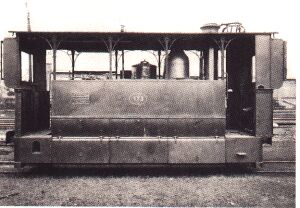
| 1885 | : | 59 km |
| 1890 | : | 754 km |
| 1895 | : | 1325 km |
As turns out of these figures, Belgium was laid full of tramways from the NMVB. The law of 1885 did order nothing about a gauge of the lines. Most provinces happily enough choosed the same gauge of 1000 mm. The normal gauge of 1435 mm of the railways was (beside a few exceptions) too large for tramways. They were normally built in de roadside of existing roads. Only in the province of Antwerp a gauge of 1067 mm (cape-gauge) was chosen. This was because of the already existing tramways in Noord-Brabant in the Netherlands. The government thought it better to make connection with these lines possible. A decision which was wrong, as would come out later.
7. Electrification
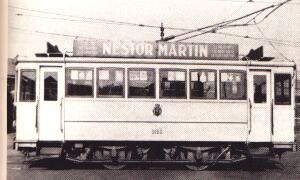
In the beginning of the tramways there was no choice of running power. The choice for horse traction had become outdated, electrical traction was not yet possible. So all lines were run with steam traction. In the countryside this was not really a large problem. But in the cities the nuisance of smoke steam and soot was too large.
Happily soon there came an alternative. That was electrification of the tramways. Just before the change of the century the NMVB started trials on the line from Brussels to Ukkel, a line with gradients of almost 5 procent. The trials turned out to be a great succes, so after 15 years already 270 km of (mostly city-)lines were electrified. Later on even more lines were electrified, even during the second world war. But all the same, the electrified lines remained island networks around larger cities, without connection of these network with each other.
In the end, the following electrical networks existed in Belgium:
- Alongside the coast from Veurne, via Ostend, Knokke to the Netherlands and in connection with this also a line from Knokke to Bruges.
- Some lines around Gent (to Zomergem, Oostakker, Merelbeke)
- Around Kortrijk, Menen and Mouscron.
- A line near Tournai.
- Some lines around Antwerp (to Hamme in the west, to Boom in the south, to Brasschaat, Schoten and Turnhout in the east)
- Around Brussels (to Grimbergen-Humbeek, Wemmel, Ninove, Leerbeek, Waterloo, Leuven-Diest, and a line to Haacht-Mechelen-Heist op den Berg)
- Around Hasselt (to Genk and to Beringen)
- Around Luik (to St.Truiden, Tongeren, Riemst, Verlaine)
- Around Verviers (to Spa, to Eupen)
- Several lines west of Mons, and the connection from Mons to La Louviere
- Several lines between La Louviere and Charleroi and a line from Charleroi to Namur
8. The first world war
Halfway 1914 the first great war came over Europe. Belgium did not escape the all dominating willings of the German neighbour. The invasion was quick, the normal life came to a standstill. Happily this stagnation dit not last for a long time. The damage for the NMVB was small. The NMVB could (in contrast to the large railways in Belgium) work the lines soon. It was necessary. The railways could not take care of the supply of the country, so little brother was obliged to do so. It happened, sometimes with trams riding over several tramlines over large distances.
Of course, in the area where the war remained (between Nieuwpoort - Veurne - Ieper) along the so called IJzer-line, operation was not possible. In this area all lines were broken down. The war remained for the full four years between 1914 and 1918 in this area. In the area south of the IJzer-line, the former network was heavily used by the allied troups, so normal operation in this area was not possible.
In the German occupied zone (most of Belgium) in the first years of the war the NMVB did not suffer much. But in later years the German army was so hungry, that a lot of the rolling stock, rails, overhead lines and much other useful attributes were transported to Germany. On the end of the war it came out, that more than 400 locomotives and almost 2000 carriages were stolen, and that of more than 4000 km line not even half of it was usable. Taking notice of thes figures it is a enormous achievement of the NMVB to carry almost twice the number of passengers during the years of the war as before the war.
9. Everything to metre gauge
As discussed in chapter 5, most lines were built in 1000 mm gauge. Only in parts of the province of Antwerp (north and east of the city of Antwerp) a large network of over 500 km was made with a gauge of 1067 mm (cape-gauge). In the beginning it looked a wise decision to make connection possible to tramways in the Netherlands. But gradually the disadvantage became larger than the advantage. Exchange of rolling stock from one line in Belgium to another in the province of Antwerp was because of this difference not possible.
Because a large part of the network was destroyed in the war of 1914-1918 and was not usable, the NMVB decided to regauge the lines north and east of Antwerp from 1067 to 1000 mm. Lines who were no more usable because war damage, were immediately regauged. On other lines a third rail was laid for a period of several years. The outermost rail was of course taken away after the project finished. In 1921 all of the regauging was done.
10. Operation under own management

Very soon after the first world war it came out, that it was very difficult for the enterpreneurs of the tramways to make profits. As has been described before, the line and rolling stock was owned by the NMVB, but the enterpreneur should make the working of the tramline himself. That was not any more possible. Soon after the war the NMVB decided to run the lines himself. For about 3500 of the 4000 km lines this worked out in the next 5 years. Only on a few profit-making lines the enterpreneur kept running, but when after 1930 the crisis also came trough in Belgium, most enterpreneurs stopped running the line.
11. The first busses
From the beginning the NMVB was running (steam and electrical) tramways. Early '20 s there also a appeared buses on the roads. Very soon they were not any longer a pioneer, and halfway the years '20 these buses turned out to be more and more reliable. For private companies it was easy to operate a line with one bus, often in heavily competition with the tramway. As the tramline often had some disadvantages in relation to a bus (single track, old fashioned technique of steam-trams, lines not running through the centers of the villages but on some distance away), the NMVB was the minor party in this contest. This was reason for the government to change in 1924 the law. The NMVB was allowed to work lines with busses instead of trams. And to make fair competition possible, it was decided by law that, on places where the NMVB runned a bus line, no other party was allowed to do so.
12. Autorails
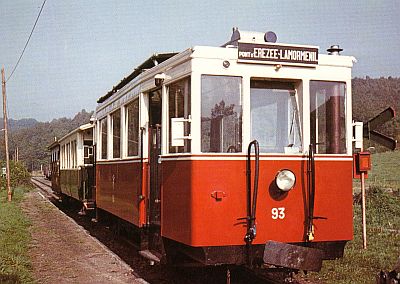
In the years after 1930 on the rural lines operation became more difficult. With the aim of lowering the cost of operation, the NMVB decided to replace the steam locomotives by a cheaper form of motive power. After some experiments which were not so faithfull, several depots experimented with rebuilding coaches to autorails. In the beginning there were problems with the (petrol) motors. But when diesel power became more sophisticated, a few hundred autorails were built which could replace the steam locs in the rural areas of Belgium. In first instance these were used for passenger transport, often with a trailer pulled by an autorail. After the second world war the autorails were also used in light goods traffic. For this reason they were rebuilt as autorail tractors (ART).
13. The second world war
Alas, l'histoire se repete, history repeats itself. In 1940 again neighbour Germany thought it necessary to enlarge its territory. But this time for the NMVB the damage was much larger. Many bridges were damaged. Also the rolling stock was more damaged than in 1914. Immediately after the armistice only a limited service could be run by the NMVB. Only after several months (and sometimes even longer) one could speak of a normal network of the tram. Because the railways were also very much damaged, the tramlines were needed very much. In 1943 the traffic demand was already twice that of 1940. On some lines the demand was so large, that it was decided to electrify some lines. The line from Antwerp to Turnhout was electrified in 1941.
At the end of the second world war no much damage was done to the tramways. O yes, some minor damages occured, and a little part of the rolling stock was transported to Germany, but after the liberation a fairly normal service could immediately be established. Only on some lines in the Ardennes were damaged more severe, this because of the long lasting fightings. These lines came te a service only after 1945.
14. The big reorganisation
War was over. For everybody a happy outcome. But for the NMVB there was a side effect. The large traffic demand during the war shrivelled up to a small amount. Very soon there were other means of transport, faster and more comfortable. This resulted in a loss for the tramways. A committee, doing research to this situation, came soon to the conclusion that much of the lines in the countryside made too much of a loss to run any longer as a (steam-)tram. Only for the networks around Mons and Charleroi and alongside the Belgian coast there were future possibilities, so said the committee.
In the beginning of the years '50 many city-networks went over to be run by bus. Also on the countryside the reorganization was hard. Of more than 4000 km of tramlines in 1950 six years later only half of it rested, in 1960 not even 1000 km existed. The reorganization went on in the years '60, so that in the beginning of the years '70 there were only trams around Charleroi and alongside the coast. In the course of the years '80 a further reorganisation around La Louviere followed, so that today only a tram exists near Charleroi and along all of the Belgian coast from Knokke via Ostend to Adinkerke.
The remaining network around Charleroi has been extended in the years '80 and '90 of the 20th century to a pre-metro network. The first idea was to change it later to a real metro in Charleroi. This idea has changed by now, but the network around Charleroi can be seen today as a real modern tramway.
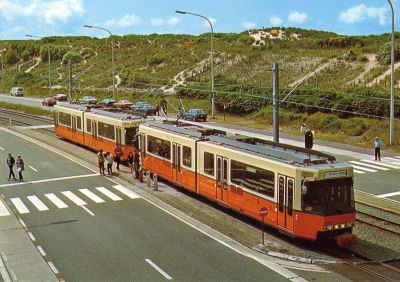
The fact that today there are many busses at the NMVB, that is out of scope of this article. As mentioned, the NMVB started running busses in the years '20. From 1950 on this went on more and more. In 1977 the busses of the railway company NMBS were incorporated and end years '80 the NMVB was united with the bus and tram companies of the large cities in Belgium. From this day on the name has been changed to "De Lijn". In this unification of city tram networks the number of tramways was enlarged with the tram of Gent, Antwerp and Brussels, and the metro of Brussels. But that is out of the scope of this article.
15. Rolling Stock
As told, the rolling stock for the managers was delivered by the NMVB. Because of this strategy it was possible to achieve stock in larger quantities. The rolling stock could then be placed on different lines. It was also possible to change stock when traffic was changing.
On a separate page you can read more about the rolling stock of the NMVB. To read it, click on the link in the menu.
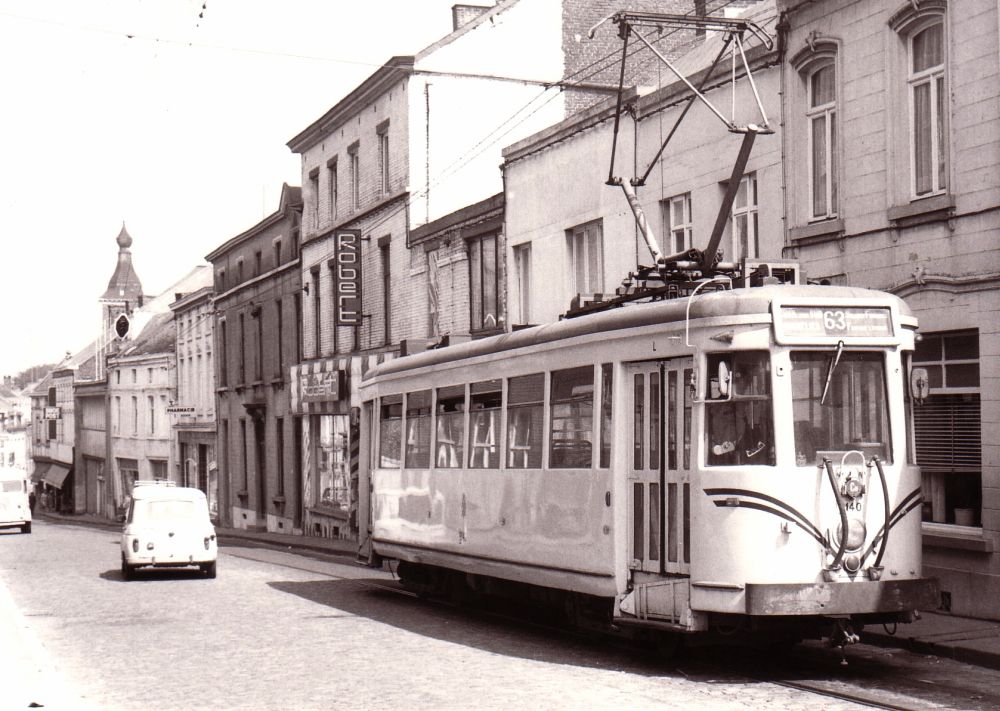
16. Finish
Who want to read something more about the NMVB, several good books have been written. A number of these books are mentioned in the page of literature.
Do you have remarks or extra information (as well positive as negative) because of this article, don't hesitate to send an e-mail. I enjoy it. To the left you can find a link to send an e-mail.
the websites of Wim Kusee